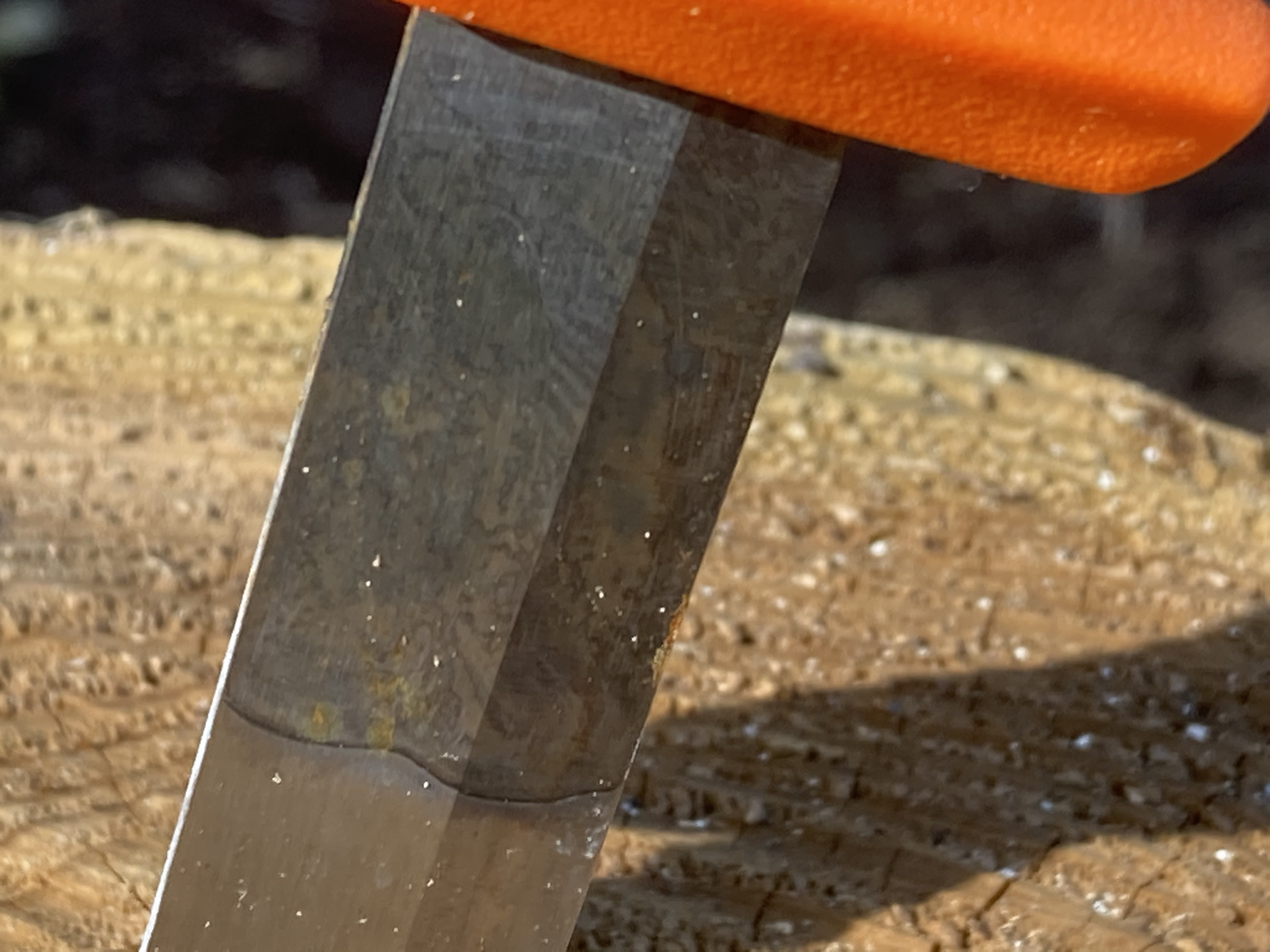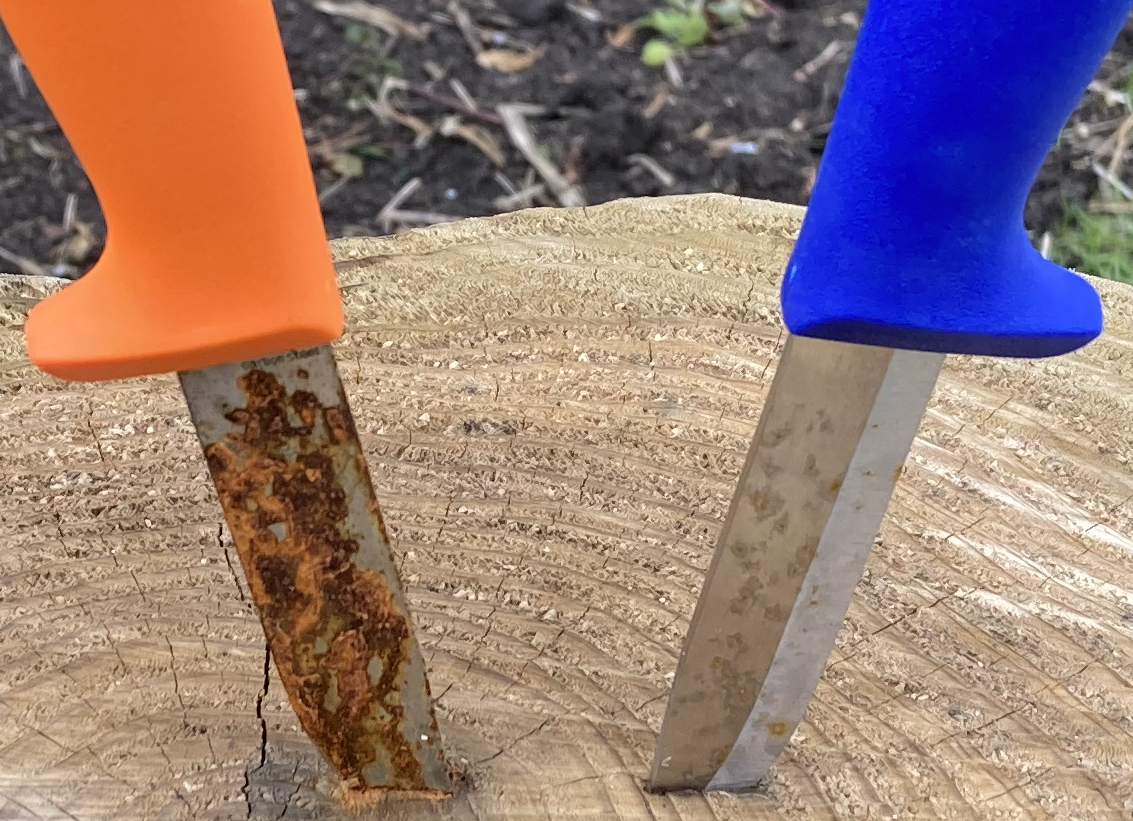Beginners Guide to Knife Making - Corrosion part 2
In part one of this Journal entry, we discussed common types of corrosion associated with knife steels and some of the differences between carbon and stainless steels. If you haven’t seen that entry you can find it here:
In this Journal entry we put that theoretical knowledge to the test through a year long practical experiment - the ‘big corrosion experiment’!
Part 2 looks in detail at the preparation undertaken for the experiment and the early development of corrosion in the test blades from first exposure through to one month.
Warning! this Journal entry is picture heavy!
Beginners guide to knife making - Disclaimer
Before I get into the main topic, let me be clear. This discussion is in no way a suggestion that there is anything wrong with Hultafors knives or the quality of the materials they use.
The intent of this Journal entry is to compare typical carbon and stainless steels, as used in knife blades, and the effect that environmental conditions has upon them. This is done with the intent to educate readers about the basics of corrosion in ferrous metals. I could have chosen any manufacturers products to illustrate the points made and meet this need with similar results.
I genuinely believe that, at the price point, Hultafors deliver a quality product that is fit for its intended purpose and makes an ideal beginners knife.
Beginners guide to knife making - The ‘big corrosion experiment’
In order to compare the corrosion effects between a typical high carbon steel knife with a stainless steel knife, an experiment was conducted spanning all four seasons of the year, sometimes in one day!
Two representative outdoor ‘working’ knives were chosen, these being the Hultafors craftsman knife with a carbon steel blade and the Hultafors craftsman knife with a stainless steel blade.
Both knives were bought brand new. You can find out more about the Hultafors range of knives and tools here:
Beginners Guide to Knife Making - Preparation
Upon receipt the knives were inspected to ensure that there were no visible signs of rust present and the blades were cleaned and degreased with acetone to remove any factory applied protective coatings.
The blades were then washed with vinegar to mimic cutting acidic foods like onions and tomatoes.
Part of the carbon steel blade was treated with a forced patina using mustard paste with four 30 minute applications in the same area to build up the density of the patina.
Beginners Guide to Knife Making - Mustard paste applied to the blade
Beginners Guide to Knife Making - The resulting patina
Part of the opposite side of both blades was coated with a salt water paste.
Beginners Guide to Knife Making - Salt paste on the carbon steel blade
Beginners Guide to Knife making - Salt paste on the stainless steel blade
The knives were mounted tip first into a soft wooden block and put outdoors fully exposed to the environment on the 7/3/2021. The knives were placed in a safe location with a ‘chicken wire’ cage around them to protect any inquisitive wildlife or neighbourhood cats.
The knives were examined regularly and notes taken of any corrosion evident.
Beginners Guide to Knife Making - Day 1
Both knives were examined after 24 hours exposure to the March weather. I think its fair to say that the effect on the salt stained carbon steel blade was striking for such a short time.
The opposite side of the blade was mainly clear of any corrosion indications although the forced patina did show signs of surface oxidisation occurring.
Beginners Guide to Knife making - Carbon blade treated with salt paste after one day
Beginners Guide to Knife Making - Carbon blade with forced patina after one day
Beginners Guide to Knife making - Stainless steel blade with salt paste day one
In Contrast, the stainless steel blade showed little visible signs of corrosion on the exposed metal. There were however, signs that ferrous material was leaching into the salt paste and oxidising.
Beginners Guide to Knife Making - Day 3
By day 3, the rust on the carbon steel knife blade was becoming well established with visible signs of multiple colours of oxides occurring.
The surface oxidisation on the forced patina was beginning to spread with some rust spots visible on the lower untreated part of the blade.
The stainless steel blade still showed no visible signs of corrosion outside of the area subjected to the salt paste. By this point most of the salt had washed away in the rain with a few surface rust stains left behind.
Beginners Guide to Knife making - Day 5
At day 5, the variation in oxidisation colours on the salt treated carbon steel blade has become more uniform. Both the untreated part of the blade and the area with a patina are showing signs of rust that is more than surface deep.
Interestingly, the rain on day 3 has dried on the stainless steel blade leaving visible water marks. Many of these water marks show signs of surface rust at their centre. The area of the stainless steel blade that was treated with salt paste looks no worse, the oxidisation seen is still surface rust.
Beginners Guide to Knife Making - 1 Week
One week in and the visible changes are beginning to slow down. The level of oxidisation on the salt treated portion of the carbon steel blade and, the untreated portion are visually similar to the levels seen on day 5. The part of the blade treated with a forced patina shows a slight increase in the density of the oxidisation present. This is mainly visible as an increased darkness to the colour of the rust in that area.
Similarly, the stainless steel blade visually shows little further degradation over that present at day 5.
Beginners Guide to Knife Making - Week 2
Two weeks of exposure to the environment has seen the oxidisation on the salt treated portion of the carbon steel blade spread across slightly more of that area.
Both the untreated surface and the area with the forced patina both show increased density of rust when compared to the previous week. The rate of increase in oxidisation is however slower than it was in the first week.
The rust on the salt treated side of the stainless steel blade shows little further development. However, the untreated side of the blade that suffered water marking shows an increase in oxidisation at the centre of each mark.
Beginners Guide to Knife Making - One Month
At one month and the corrosion has really started to set into the blade steels.
The rust on the salt treated side of the carbon steel blade has spread across approximately 80% of the blade surface. The rust in this area is now visibly lifting and flaking away from the parent metal.
On the opposite side of the blade, the area with the forced patina is also visibly showing rust spots that are bubbling and flaking from the surface.
The untreated part of the blade is still relatively rust free.
The stainless steel blade is relatively corrosion free in most places. However where corrosion is evident, at the water marks and where the salt paste was placed, the rust is beginning to develop into the surface of the material.
Beginners Guide to Knife Making - Deep flaking rust forming on the carbon steel blade at the site of the salt paste contamination.
Beginners Guide to Knife Making - A surprising amount of corrosion on what common wisdom would tell us is a protective layer.
Beginners Guide to Knife Making - Deep rust ‘pits’ forming on the stainless steel blade.
In the next part to this Journal entry we will look at how the corrosion develops on our test blades beyond one month up to the first year.



























